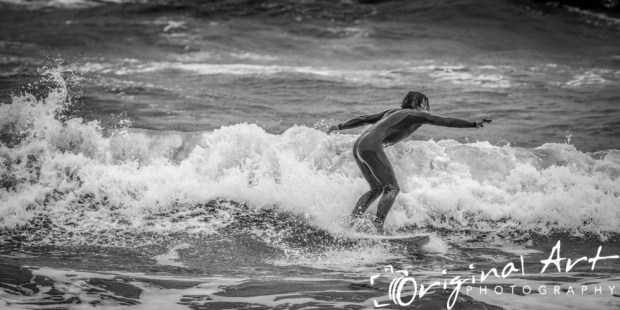Sports Photography – Action Photography

Sports photography can be quite challenging. How can you get images that give you a real sense of the action? Generally speaking, for most sports the key is to use a fast shutter speed to help you to freeze the action. For example, the image of the surfer above was taken with a shutter speed of 1/2000th of a second. This very fast shutter speed enables us to see details that would otherwise be blurred. Every droplet of water from the sea spray is frozen. We can see something of the tension as he battles to ride the wave.
Sports photography is normally best done with large apertures. This helps us to draw attention to the subject and remove distractions. The image above was shot at f/3.5 at 200mm. The wide aperture also makes it easier to keep the shutter speed fast. To make life easier, you can select your aperture and shutter speed in Manual Mode on your camera and then set the ISO to auto. Using auto ISO helps to ensure even exposures. With modern digital cameras, working at higher ISOs is less of a problem than it used to be. Keeping the shutter speed fast enough to freeze the action is essential for certain types of sports photography such as photographing surfing. So, it is best to ensure that your camera doesn’t have the option of choosing a slow shutter speed. Lock that in and force the camera to change only the ISO.



Ball sports such as football also work well with a fast shutter speed. You will tend to need around 1/1000th of a second or so in order to freeze the ball in mid air. As with all sports photography, you will need to be flexible and adjust your settings according to what is happening. The faster something is moving, the faster the shutter needs to be in order to get a sharp image of it. If you find you are getting blurred images, try a faster speed. Also, it is worth switching off any VR (vibration reduction) or OS (optical stabilisation) systems when photographing at this speed. There is no real benefit in leaving them on as the shutter speed itself is what will ensure shake doesn’t affect your image. However, there is a small chance that leaving them switched on can have a negative effect on your image or your autofocus and continuous shooting.




For some sports, such as cycling, you may also want to try panning. For vehicles (cars, bikes, planes, etc) it can look a bit weird if they are just frozen still. A bicycle can look odd if it has been frozen too much as it looks like it is standing upright and standing still. To bring back a sense of movement you need to try panning. This means using a slower shutter speed and following your subject in a smooth motion. You still want them to be in focus, so you need to focus accurately and keep your camera very steady as you pan. A slightly slower shutter speed enables the wheel spin to register as a blur – giving a sense of movement. It also enable you to blur the background, which again helps to give a sense of speed.




The cycling images above of the female cyclist were taken at about 1/150th – 1/200th of a second. The speed you need depends on how fast your subject moves and how quickly you need to pan. The closer you are, the faster your panning movement will be. From further away, because of the angle, you can pan more slowly. It will take a bit of experimentation to get results you are happy with. But, it is well worth having a go! For closer shots of the cyclist’s face, of course it is sensible to use a fast shutter speed to get a sharp, clean photo. Whether you are panning or going for a close up, make sure you focus on the eyes as far as possible. You should also put your autofocus mode on continuous so that it keeps adjusting as the subject moves. Finally, use burst mode (continuous shooting) to get several frames quickly to give you a better chance of a good image. The two images from the Tour of Britain cycling event were taken using a faster shutter speed of around 1/1500th second as I wanted to get the cyclists really sharp. They were taken at 200mm, so any movement would increase the chances of blur. Fast shutter speeds help overcome this.
© Joe Lenton, September 2015


Pingback: Obtaining Guidance In Trouble-free Secrets Of [topic] | Net Hustlin
Pingback: Why are photos sometimes not sharp? How to get sharp images